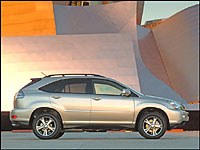Fab Labs
 It's not often that the future reveals itself to us in the form of a pink key chain.
It's not often that the future reveals itself to us in the form of a pink key chain.
The Center for Bits and Atoms at MIT engages in research on "personal fabricator" devices -- machines able to make a wide variety of physical objects out of base materials. The Center's classes "How to Make (Almost) Anything" and "How to Make Something That makes (Almost) Anything" are wildly popular. But the Center has a bigger mission than just transforming material production: they want to help people in the developing world use these advanced technologies to solve local problems.
To this end, the Center for Bits and Atoms has developed the "Fab Lab," $20,000 worth of material design and fabrication equipment which can be used nearly anywhere. Six Fab Labs exist, each with a particular focus on local needs: South End Technology Center, in Boston (building community wireless networks); Lygen Alps, in Norway (building larger-scale wireless networks and animal collars to aid nomadic herding); Vigyan Ashram, in India (building agricultural instruments); Bithoor, in India (building 3D scanners and printers for local artisans); TEC, in Costa Rica (building educational tools); and the Takoradi Technical Institute, in Ghana. It's at the Takoradi Technical Institute that flourescent pink key chains have become the most popular fabricated item among the young students. But that's not all they build:
Beyond key chains, the Ghana lab is working on practical projects including antennas and radios for wireless networks and solar-powered machinery for cooking, cooling and cutting. Each of these activities was developed in collaboration with local users, ranging from street children to tribal chiefs, to address the most important local needs.
The labs are well-equipped (especially given the low cost), and the goal is for them to be able to produce the same set of equipment for another lab -- in effect, to become (very slow, human-aided) replicators:
Instead of bringing information technology to the masses, the fab labs bring information technology development to the masses," Gershenfeld said. "For our education and outreach efforts, rather than telling people about what were doing, we thought wed help them do it themselves. Weve been pulled around the world by the voracious demand we've found each time weve deployed a fab lab. The fab labs provide an accessible approximation of the tools CBA has on campus, and over time, [CBA Director Neil] Gershenfeld said, components of the labs will be replaced with components made in the labs until eventually the fab labs themselves are self-reproducing.Each fab lab comes equipped with computer-controlled fabrication tools, open-source computer-aided design and manufacturing software and associated electronic components and test equipment. Capabilities include a laser cutter for 2-D and 3-D structures, a sign cutter for plotting interconnects and electromagnetics, a 3-D precision milling machine for applications such as making surface-mount circuit boards and programming tools for low-cost, high-speed embedded microcontrollers.
The Center for Bits and Atoms was launched in the Fall of 2001, supported by the National Science Foundation. The Center's Annual Reports give a good overview of each year's efforts, both in research towards personal fabricators and in the development and deployment of Fab Labs. The three reports -- from 2002, 2003, and 2004 -- provide well-illustrated guides to the cutting-edge of fabrication technology and the uses it can have in the developing world.
I have to say, when I first read this article, I got a bit dizzy: fabricator systems will be useful in the West, where material goods markets are well-established and relatively efficient, but they will be utterly revolutionary in the developing world. The Fab Labs are, at best, a Version 0.1 of such future fabricator devices, but the important story here isn't the hardware, it's the combination of research expertise and social intent demonstrated by the Center for Bits and Atoms. They are in the early days of completely changing the world.
(Found via Cyborg Democracy)
 In a nice bit of serendipity, just as we were posting today about
In a nice bit of serendipity, just as we were posting today about 

 Hybrid cars are defined by having an electric motor as part of their propulsion system, either as an assist to the gasoline engine (as with the Honda design) or as a separate, lower-speed drivetrain (as with the Toyota and Ford designs). But the electric motor isn't the only element that makes a hybrid efficient. A feature which almost seems like an aside actually accounts for a decent amount of fuel (and emissions) savings: the engine is turned off whenever the vehicle comes to a stop, so there's no sitting and idling. Once the brake pedal is released, the engine comes right back on, with no noticeable delay.
Hybrid cars are defined by having an electric motor as part of their propulsion system, either as an assist to the gasoline engine (as with the Honda design) or as a separate, lower-speed drivetrain (as with the Toyota and Ford designs). But the electric motor isn't the only element that makes a hybrid efficient. A feature which almost seems like an aside actually accounts for a decent amount of fuel (and emissions) savings: the engine is turned off whenever the vehicle comes to a stop, so there's no sitting and idling. Once the brake pedal is released, the engine comes right back on, with no noticeable delay. If you're in the Boston area this week, be sure to head over to MIT Wednesday evening for the presentation "
If you're in the Boston area this week, be sure to head over to MIT Wednesday evening for the presentation " The
The  WorldChanging friend
WorldChanging friend  Sometime after 2010, the European Space Agency will be launching the
Sometime after 2010, the European Space Agency will be launching the  We may be able to cross one potential disaster off the list (but do it in pencil).
We may be able to cross one potential disaster off the list (but do it in pencil).
 Naturalist David Bellamy
Naturalist David Bellamy  I ran across a couple of interesting information resources recently, and thought them worth sharing.
I ran across a couple of interesting information resources recently, and thought them worth sharing.
 Who would ever think that building something to function deep in Antarctica in the middle of winter would be the cheap option?
Who would ever think that building something to function deep in Antarctica in the middle of winter would be the cheap option? In coming weeks, Insights, Civic Hybrids, and Priuses (Prii?) won't be the only hybrid-electric vehicles on the road. The Ford Escape hybrid SUV -- which we
In coming weeks, Insights, Civic Hybrids, and Priuses (Prii?) won't be the only hybrid-electric vehicles on the road. The Ford Escape hybrid SUV -- which we  Looking for something to do this weekend? Live in Massachusetts, or can get there easily? Check out the
Looking for something to do this weekend? Live in Massachusetts, or can get there easily? Check out the  Many folks I know in the SF area managed to snag themselves a fancy desk chair at fire-sale prices during the dark days of the dot-com bust. If you weren't quite so lucky (that is, if you weren't able to plunder the grisly remains of shattered dreams) or you're just in need of a good new chair,
Many folks I know in the SF area managed to snag themselves a fancy desk chair at fire-sale prices during the dark days of the dot-com bust. If you weren't quite so lucky (that is, if you weren't able to plunder the grisly remains of shattered dreams) or you're just in need of a good new chair,  The
The  European automakers at the
European automakers at the  PhysOrg yesterday had two nanotechnology-related reports of particular interest to WorldChangers.
PhysOrg yesterday had two nanotechnology-related reports of particular interest to WorldChangers. "
" French automaker Peugeot is set to start its third
French automaker Peugeot is set to start its third  If you're looking for a catalog of the cutting edge, I just found one.
If you're looking for a catalog of the cutting edge, I just found one.